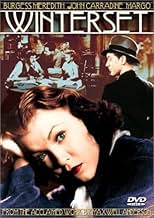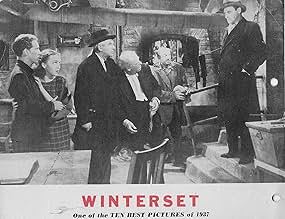Sixteen years ago, Italian socialist John Carradine was found guilty of murder on circumstantial evidence, which his wife and son were convinced was trumped up. Now the son, grown into Burgess Meredith, wanders the countryside, looking for the people who murdered his father: gangster Eduardo Cianelli, who killed the man his father was executed for killing; Edward Ellis, the judge who found him guilty in a rigged trial; and Paul Guilfoyle, who had witnessed the murder, and had refused to testify. Now fate has brought them together in the slum dwelling where Guilfoyle's father, Maurice Moscovitch, and his sister, Margo, live.
The copy of the movie I looked at was in poor condition, rather fizzy, and often obscured by the pelting rain that permeates most of the outdoor scenes. The line readings are stagy; many of the cast members had appeared in the stage play by Maxwell Anderson, and director Alfred Santell has made no effort to curb their performances. Instead, he has chosen to make it a film by dramatic camera angles and idiosyncratic, even quixotic editing choices. It's clearly a prestige production for RKO, although it garnered just two Oscar nominations: for Perry Ferguson's set designs, and Nathaniel Shilkret's score. It's very compelling, but its evident artiness doesn't work in its favor, with its poetical and rage-filled dialogue so evidently fake that it almost campaigned against the naturalness that mid-1930s movies all but demanded. Still, a cleaner, clearer copy might have changed my opinion.






































